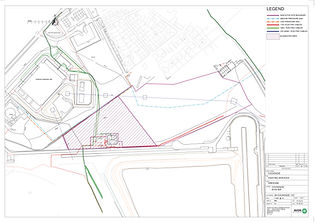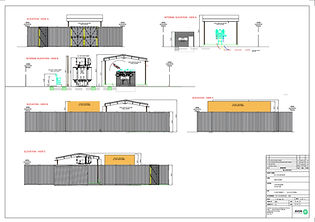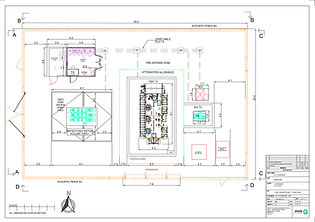Welcome to the
Cockenzie Battery Energy Storage System (BESS)
Consultation Website
Project update
A Section 36 application for the proposed Cockenzie Battery Energy Storage System was initially submitted to the Scottish Government’s Energy Consents Unit in August 2023. The application is currently under consideration.
We are grateful to everyone who attended the public events and provided us with feedback.
We’ll update this site with new information from time to time, such as a new section below that addresses recent questions around fire safety.
Cockenzie BESS: comprehensive, robust safety measures
Safety is our highest priority. Gresham House owns and operates 29 battery energy storage systems across Britain, with more in development. Since 2016, when the first became operational, none of the sites has ever experienced a fire safety failure.
The Cockenzie BESS has been designed with multiple, overlapping layers of safety that work together to monitor, detect, and prevent any risk of fire or smoke.
From early off-gas detection and temperature controls to active cooling and suppression systems, every component is engineered to stop an issue before it starts.
The site is fully equipped with robust containment and protection systems— water suppression, fire-resistant containers and deflagration vents—to ensure it’s quickly managed and doesn’t escalate.
Battery fires are extremely rare, but we take the risk seriously. As part of our section 36 application, we asked an independent fire safety assessor to ensure our battery storage fire safety design and systems were fully compliant with the National Fire Chiefs Council requirements. Additional safety features have also been incorporated into the fire safety system design.
The Cockenzie BESS fire safety system design and proposed future site safety management systems are based on the principle of preventing any battery fire from occurring on site.
Below we have summarised some of the main safety features, but you can read the full Battery Storage Safety Management Plan below:
Monitoring and prevention
We will continuously monitor the condition of each battery cell and rack in every container. Any battery cell abnormality will be identified and monitored or switched off if required.
The site has been designed with multiple layers of safety built into every battery unit and across the wider infrastructure.
Each container will have:
-
early off-gas detection (which identifies chemical signs of battery failure before heat or smoke is present)
-
heat and smoke detectors
-
internal cooling systems
-
internal water suppression systems to prevent thermal runaway and reignition
-
deflagration vents to safely vent pressure upwards
The containers will have a minimum of 60 minutes of fire resistance, and the spacing between containers has been verified as NFCC compliant. All battery containers will be spaced following NFCC guidance, away from any combustible material such as vegetation.
The early warning system means that, should a risk be detected, safety measures will launch immediately and automatically. The containers will fill with water, which stops any smoke escaping and thoroughly cools the equipment, and they will be electrically isolated.
This minimises the risk of any thermal runaway and means any gas or fumes are trapped within water droplets inside the container - and don’t escape into the surrounding atmosphere.
All safety measures follow the latest guidance from the National Fire Chiefs Council and associated international BESS test requirements, such as NFPA 855.
Water suppression
Each battery container will have its own automatic water suppression system. Liquid-based systems are far more effective than gas systems at cooling batteries and preventing re-ignition and ensuring the continued safe operation of the BESS.
The main water suppression system is designed to be capable of operating continuously for up to 12 hours, with enough on-site water storage to ensure both external fires and any container issue can be addressed simultaneously.
Water supply and access
The site fire hydrant supply will be sufficient for supplying the required flow rates as per the NFCC guidance requirements. The site will also have bulk water storage tanks with a capacity of 804,000 litres to provide an extra level of safety.
This site has multiple access points that will allow the entry of fire appliances and total access to the site for firefighting efforts. The access points are situated in such a way that fire services will not have to run a length of hose exceeding 60 metres from their point of connection (firefighting appliance/on-site hydrant).
Battery choice
We will use LFP battery technology, which is recognised as one of the safest lithium options on the market. These batteries are housed in containers with multiple built-in detection and suppression systems to catch any issue before it becomes a fire hazard.
The LFP batteries used at this site will have been assessed in accordance with UL 9540A (testing the fire safety hazards associated with propagating thermal runaway within battery systems), according to the information given by the manufacturer.
Multilayered safety measures, minimal risk
While no system can ever claim zero risk, the Cockenzie BESS has been designed with such extensive, multi-layered safety measures that the likelihood of fire is extremely low. These features mean the local community can be confident that the system is safe and well protected.

Welcome to the public consultation website for proposed development at Land south of Inglis Farm, Cockenzie, East Lothian, EH32 0JT.
Gresham House are proposing to construct and operate a Battery Energy Storage System (BESS).
They will be connecting into the Scottish Power Transmission (SPT) network who are building their own substation. This is at a point in the network where renewable generation, together with Battery Storage, can provide this power, quality and resilience.
Locating the BESS project adjacent to the SPT Cockenzie Substation provides a viable and cost effective connection at this important node of the network.
SPT are a distribution and transmission network operator who take electricity generated from power stations, windfarms and various other utilities and transport it through their vast transmission network. Their systems are crucial to the delivery of the Government’s renewable energy objectives.
An initial consultation exhibition was held on 1st June 2023. A second consultation will now be held prior to an application being submitted to the Energy Consents Unit (ECU).
The proposed plans will be available to view on this website prior to an application being submitted to the ECU.
Appointment only surgeries are being held virtually between Thursday 13th July - Thursday 3rd August 2023. Virtual appointments are available between 9am-5:30pm Mondays - Fridays. If you cannot make an appointment during these times, please contact us and we can make alternative arrangements.
Alternatively, there may be an opportunity to book an in-person appointment at Willow Room, Cockenzie House and Gardens, 22 Edinburgh Road, Cockenzie, East Lothian, EH32 0HY on Thursday 20th July 2023 between 3pm - 7pm. Please email Leeds.Admin.Team@pegasusgroup.co.uk or call 0113 287 8200 to book a 15 minute individual virtual or in-person appointment where members of the project team with Pegasus Group, the planning consultants, will be available at appointments to listen to your thoughts and answer any questions you may have.
If you would like an in-person appointment, please contact us by 5pm on the 13th July.
Following the second public consultation, the application will be prepared and submitted to the ECU.
Once the application is submitted to the ECU, all formal application material will be publicly available to view on their website.
Why This Site?
The Scottish Government has set a target within The Climate Change (Emissions Reduction Targets) (Scotland) Act 2019, to achieve net-zero emissions by 2045, with an initial target of being able to achieve this for short periods by 2025. National Grid estimate that 13GW of batteries are required to ensure that energy generated by renewables can be stored when it is not required, and then used when it is and to provide power quality services as traditional generation is phased down.
The site is located within Land at Former Cockenzie Power Station under policy PROP EGT1 within the East Lothian Council Local Development Plan 2018. This policy states “Land at the above site will be safeguarded for future thermal power generation and carbon capture and storage consistent with National Development 3. Land at Cockenzie may also present significant opportunities for renewable energy-related investment. The council will work together with developers, the landowner, the relevant agencies, local organisations and interested parties, including local residents to ensure that the best use is made of the existing land and infrastructure in this area. If there is insufficient land for competing proposals, priority will be given to those which make best use of the location’s assets and which will bring the greatest economic benefits. Development proposals must avoid unacceptable impact on the amenity of the surrounding area, including residential development.”
As such, the site is considered to be suitable for battery energy storage use.
As part of the proposals a substation is proposed on the site which the BESS will connect to. The substation will be at a point in the network where renewable generation, including Battery Storage, can provide this power quality and resilience. Locating the substation and BESS on the same site, ensures a cost effective and viable connection at this important node of the network.
The proposed battery storage energy facility would provide a significant contribution to the energy storage targets in the timescales necessary to contribute to the UK’s progress in meeting its renewable energy targets. It would also provide rapid-response electrical backup to the Scottish Power Transmission, providing a flexible system to balance energy supply and demand.
LANDSCAPE PLAN

What is Proposed?
The proposal consists of the construction and operation of a Battery Energy Storage System. Access to the site will be taken from the south of the site. The associated equipment will be split between two areas of the site and would comprise:
-
Battery storage units – battery units arranged in rows around 7m in length, around 2.8m wide, and around 3.1m in height;
-
Switchgear containers – around 20m in length, around 3.5m wide and around 4.1m in height;
-
Inverters and transformers local to the batteries will be around 3m in height;
-
3 substations and substation equipment, with some elements being in the region of 14m in height. Further details are as follows:
Substation 1 (132kV)
- Control room – around 6.5m in length, around 3.9m wide and 3m in height;
- 132kV transformer - around 6m in length, around 3.5m wide and around 3.8m in height;
- Removable panels;
- 132kV switch house enclosure around 8.1m in length, around 6m wide, and around 6.3m in height;
- Auxiliary transformer around 2.6m in length, 2.4m wide and around 3m in height;
- Acoustic fence around 4m in height
Substation 2 (132kV)
- Control room/auxiliary room – around 11m in length, around 4m wide and around 3m in height;
- 2no. 132kV transformers around 11m in length, around 9m wide and around 5.7m in height;
- Fire wall to south and in-between the 2no. 132kV transformers, around 6.1m in height;
- Acoustic fence around 4m in height;
- 132kV switch house enclosure around 15m in length, around 11m wide and around 8.2m in height;
- Auxiliary transformer around 2.6m in length, 2.4m wide and around 3m in height.
Substation 3 (400kV)
- Auxiliary transformer around 2.6m in length, 2.4m wide and around 3m in height;
- Customer control room around 11.4m in height, 3.3m wide and 2.5m in height.
Other Details
- Landscaped bunds;
- Landscape features around the site will include trees and hedgerow planting;
- Site fencing, access gate and CCTV – around 2.4m high security mesh fence with access gates, CCTV and light poles to be around 5m high.
- Wires to existing pylons
Technical Plans
Here are our current plans for the scheme. We would welcome your thoughts on these.

















Comments
The comments period for public consultation is now closed. Comments on the application can be made directly to ECU. Details to access the application on ECU’s portal are provided in the ‘Application Documents’ section below
Application Documents
APPLICATION
An application for the Cockenzie Battery Energy Storage System (BESS) Transformers, Substations and Associated Infrastructure was submitted under the Section 36 application process to the Scottish Government’s Energy Consents Unit on 19th January 2024, application ECU00004926 and is a live application.
The submitted application for the Cockenzie BESS is comprehensive in its description and analysis of design, ecology, noise, heritage, landscape and transport features of the project. You can view the documents on the Scottish Government Energy Consents Unit website at https://www.energyconsents.scot, application reference number ECU00004926 Cockenzie BESS,
Or via link: Scottish Government - Energy Consents Unit - Application Details
The below documents have been submitted as part of the application and can be downloaded.
Submitted Drawing Package
Submitted Reports Package
November 2024 Update
Application ECU Reference: ECU00004926 is still under consideration by the Scottish Ministers. This application is being amended to sub-divide the site with Parcel A being retained, and a new application for Parcel B. The collective administrative output being that two S36 consents can be issued and assigned accordingly. There are no material changes to the layout/design as previously assessed and the proposed scheme is considered to be as per the previously submitted application. The two applications are effectively the same, retaining the same red line boundary plan; supporting information; mitigation/enhancements. Common elements, such as substations, are retained within both schemes and the formation of the two parcels are reflected within the revised plans. Consequently, the submissions made to the Scottish Ministers seeks consent to construct and operate:
• Application A (Amendment): "Application for Battery Energy Storage System and Associated Infrastructure amendment to application only, to sub-divide the Site with 'Parcel A' being retained, comprising 240 MW of BESS and Associated Infrastructure).
• Application B New "Application for Battery Energy Storage System and Associated Infrastructure (amendment to application ECU Reference: ECUO0004926, to sub-divide the Site with Parcel B being formed comprising 102 MW of BESS and Associated Infrastructure).
You can view the documents of Application B on the Scottish Government Energy Consents website at https://www.energyconsents.scot, application reference number ECU00006022, or via link: https://www.energyconsents.scot/ApplicationDetails.aspx?cr=ECU00006022
As part of this updated plans have been prepared as well as an Addendum Statement for each application. These can be viewed via the below links.
The Addendum Statements are intended to be read as an addendum to the previously submitted documents and plans which was submitted with the application in January 2024 It accompanies a submission amending the application and is complemented by an amended plan pack.
Information previously submitted within the originally submitted documents has not been repeated and as such the Addendum only deals with matters raised as a result of the proposed amendments to the application and amended submitted plans.
The previously submitted reports have assessed a worst-case scenario i.e. considering Parcel A and Parcel B alongside each other for example, in terms of noise, visual impacts, ecology and highways. Whilst separate consents are now being sought for the two parcels, the amendments/new application are only required to facilitate two consents for assignment purposes only. The likelihood is that the two parcels will be constructed side by side. However, by ensuring that the mitigation and enhancement requirements set out within the supporting documents and plans are delivered (in the event that only one parcel is commenced and completed, or that they come forward at different times), they have (in their entirety) been retained in this submission and conditions can be imposed accordingly. On this basis the mitigation enhancement measures are potentially an over provision in some cases
The application has been subject to statutory consultee comments and found to be acceptable by East Lothian Council, Nature Scot, RSPB Scotland, Historic Environment Scotland, Network Rail, Transport Scotland, Scottish Forestry and Scottish Water. The underlying development is fundamentally the same and all mitigation enhancements remain.
On this basis as such the conclusions of the previously submitted reports remain valid.
Amended Application A - Updated Plans & Reports
Amended Application B - Updated Plans & Reports
P23-0093
Pegasus Group
Green Lane
Garforth
Leeds
LS25 2AF





![P23-0093 - Cockenzie Consultation Boards 2nd Phase 1I[69]-2.jpg](https://static.wixstatic.com/media/7ffde8_99782daefbfe41b4b1a3e6996bd632de~mv2.jpg/v1/fill/w_208,h_294,al_c,q_80,usm_0.66_1.00_0.01,enc_avif,quality_auto/P23-0093%20-%20Cockenzie%20Consultation%20Boards%202nd%20Phase%201I%5B69%5D-2.jpg)
![P23-0093 - Cockenzie Consultation Boards 2nd Phase 1I[69]-3.jpg](https://static.wixstatic.com/media/7ffde8_8a171899f9f94d2c83e978a7a472297c~mv2.jpg/v1/fill/w_208,h_294,al_c,q_80,usm_0.66_1.00_0.01,enc_avif,quality_auto/P23-0093%20-%20Cockenzie%20Consultation%20Boards%202nd%20Phase%201I%5B69%5D-3.jpg)
![P23-0093 - Cockenzie Consultation Boards 2nd Phase 1I[69]-4.jpg](https://static.wixstatic.com/media/7ffde8_1f9acd19fd564c018a097f6c90d5eebc~mv2.jpg/v1/fill/w_208,h_294,al_c,q_80,usm_0.66_1.00_0.01,enc_avif,quality_auto/P23-0093%20-%20Cockenzie%20Consultation%20Boards%202nd%20Phase%201I%5B69%5D-4.jpg)
![P23-0093 - Cockenzie Consultation Boards 2nd Phase 1I[69]-5.jpg](https://static.wixstatic.com/media/7ffde8_2dd35bd4a74c46c2a1123827cdb31ab8~mv2.jpg/v1/fill/w_208,h_294,al_c,q_80,usm_0.66_1.00_0.01,enc_avif,quality_auto/P23-0093%20-%20Cockenzie%20Consultation%20Boards%202nd%20Phase%201I%5B69%5D-5.jpg)
![P23-0093 - Cockenzie Consultation Boards 2nd Phase 1I[69]-6.jpg](https://static.wixstatic.com/media/7ffde8_5de1fc0a90c44dac87944ed85caba6f3~mv2.jpg/v1/fill/w_208,h_294,al_c,q_80,usm_0.66_1.00_0.01,enc_avif,quality_auto/P23-0093%20-%20Cockenzie%20Consultation%20Boards%202nd%20Phase%201I%5B69%5D-6.jpg)
![P23-0093 - Cockenzie Consultation Boards 2nd Phase 1I[69]-7.jpg](https://static.wixstatic.com/media/7ffde8_1cf0f0c84810481ea307b5afeb30f16c~mv2.jpg/v1/fill/w_208,h_294,al_c,q_80,usm_0.66_1.00_0.01,enc_avif,quality_auto/P23-0093%20-%20Cockenzie%20Consultation%20Boards%202nd%20Phase%201I%5B69%5D-7.jpg)
![P23-0093 - Cockenzie Consultation Boards 2nd Phase 1I[69]-8.jpg](https://static.wixstatic.com/media/7ffde8_100315e784b3494b9ea30bc68dabc331~mv2.jpg/v1/fill/w_208,h_294,al_c,q_80,usm_0.66_1.00_0.01,enc_avif,quality_auto/P23-0093%20-%20Cockenzie%20Consultation%20Boards%202nd%20Phase%201I%5B69%5D-8.jpg)